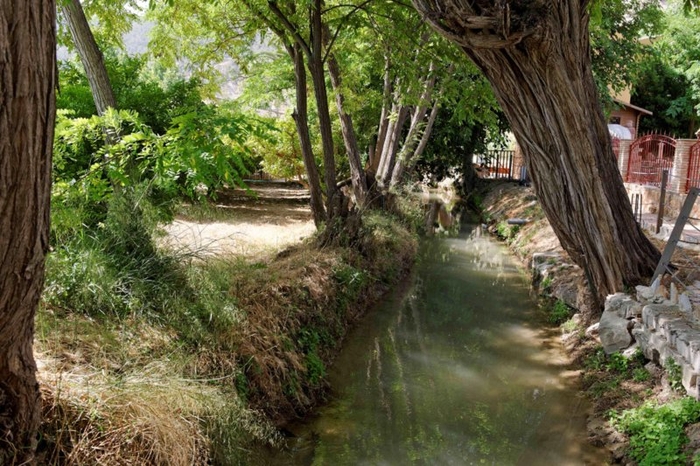
To be listed on the haciendadelalamo TODAY MAP please call +34 968 018 268.
The Acequia Andelma, Cieza
The Andelma waterway, Cieza
The fertile River Segura valley is fed by the waters from the river, and has attracted occupation since  prehistory due to its rich soils and abundance of water.( See History of Cieza)
prehistory due to its rich soils and abundance of water.( See History of Cieza)
Alongside the river is an attractive treelined pathway, and just before the main bridge crossing the flat riverside areas of orchards, is the Molino de Teodoro, a restored watermill used for grinding flour during the last 500 years.
The watermill can be visited as part of guided group visits to the town, and visits start with the source of the water feeding the mill with its power: the Acequia Andelma.
This is one of the most important waterways within the Cieza irrigation network and although it is certainly of Islamic origin could also well be part of the original Roman network of irrigation systems which existed in this  area during the Roman occupation.
area during the Roman occupation.
The Romans are known to have built several villas in this part of the River Segura 2000 years ago, farming the rich soil and irrigating from the river, leaving behind irrigation channels nearby in the fields of La Parra, and this same area was certainly extensively farmed during the Islamic occupation when the settlement of Medina Siyasa was at its zenith between the 10th and early 13th centuries.The windmill was built in the last few years of the 15th century and is recorded as being in existence in 1507, as the town rebuilt following the beginning of the rule of Isabella and Fernando, who successfully defeated the last Moorish rulers in Spain, and removed the ever present threat of incursions from Granada.
As the Christians built a new town by the river, the watermill was also constructed, fed by the waters of the  Acequia Andelma.
Acequia Andelma.
Much of the acequia appears natural, a water channel bordered with vegetation, only small areas of it visibly channelled using a brickwork and concrete structure, although today much of the infrastructure has overgrown as the job is now carried out by subterranean tubing, although the original structure can clearly be seen behind the watermill.
A path leading up behind the watermill forms part of one of the major walking routes surrounding Cieza and which can be enjoyed by those who enjoy walking .
The windmill was acquired by the council of Cieza in the 1990’s for rehabilitation and restoration, and can be visited by prior arrangement with the tourist office as part of a guided group visit.
El Museo Molino deTeodoro
Paraje del Estrecho Paseo Ribereño s/n 30530 Cieza (Murcia)
To book visits, contact:
Oficina de Turismo de Cieza, Plaza de España
Tel: 968 453 500
Click for contact box and map details.


